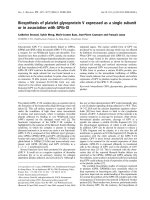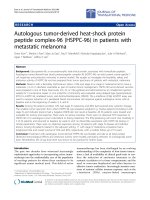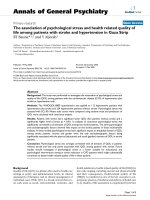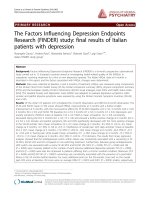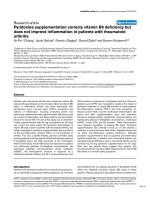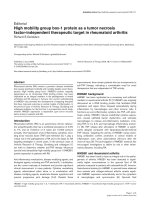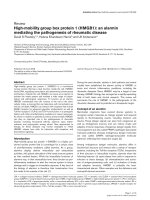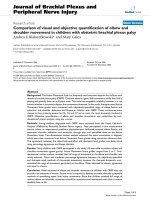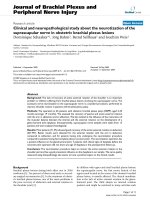Báo cáo y học: "High mobility group box protein-1 (HMGB-1) as a new diagnostic marker in patients with acute appendicitis" potx
Bạn đang xem bản rút gọn của tài liệu. Xem và tải ngay bản đầy đủ của tài liệu tại đây (546.96 KB, 6 trang )
ORIGINAL RESEARCH Open Access
High mobility group box protein-1 (HMGB-1) as a
new diagnostic marker in patients with acute
appendicitis
Yavuz Albayrak
1*
, Ayse Albayrak
2
, Muhammet Celik
3
, Ibrahim Gelincik
4
, Ismail Demiryılmaz
5
, Rahsan Yildirim
6
and
Bunyami Ozogul
7
Background: The aim of this prospective study was therefore to evaluate the diagnostic value of preoperative
serum High Mobility Group Box Protein-1 (HMGB-1) levels in patients with Acute Appendicitis (AA) who show
normal white blood cell count (WBC) counts.
Method: Our study was carried out from October 2010 through November 2010 and included 20 healthy control
group participants and 60 patients who presented at the emergency department of Erzurum Training and Research
Hospital in Turkey with acute abdominal pain complaints, who were pathologically diagnos ed with AA after
laparotomy, and who agreed to participate in the study.
Results: Of the 60 patients who underwent appendectomies, 36 were male and 24 were female, and of the
healthy group, 12 were male and 8 female. The age averages of the patients in Groups 1, 2 and 3 were,
respectively, 31.3+15.4, 34.0+16.3 and 31.0+13.1 years. The WBC averages of Groups 1, 2 and 3 were, respectively,
7.41+2.02 (x10
9
/L), 15.71+2.85 (x10
9
/L) and 8.51+1.84 (x10
9
/L). The HMGB-1 levels for Groups 1 (healthy persons),
2 (AA patients with high WBC counts ) and 3 (AA patients with normal WBC counts) were, respectively, 21.71 ±
11.36, 37.28+13.37 and 36.5 ± 17.73 ng/ml. The average HMGB-1 level of the patients with AA was 36.92 ± 15.43
ng/ml while the average HMGB-1 value of the healthy group was 21.71 ± 11.36 ng/ml.
Conclusion: The significantly higher levels of HMGB-1 in AA patients compared to healthy persons infer that
HMGB-1 might be useful in the diagnosis of AA. Use of HMGB-1, especially in patients with normal WBC counts,
will reduce the number of unnecessary explorations.
Background
Acute app endicitis (AA) is a common abdominal surgi-
cal emergency that can affect individuals of all ages,
with a lifetime occurrence of approximately 7% [1,2].
AA is commonly diagnosed through a combination of
clinical information including symptoms and physical
examination findings, traditional biomarkers (e.g., white
blood cell count (WBC), mean platelet volume (MPV),
absolute neutrophil count (ANC), and C-reactive protein
(CRP)) and radiographic imaging (e.g., ultrasound and
computed tomog raphy scans) [3-6]. Howev er, preopera-
tive diagnostic difficulties still occur, resulting in a
percentage of incorrect diagnoses tha t can reach up to
20% in the general population, and even up to 40% in
women of reproductive age [7-9].
Despite the multiple modern diagnostic tools currently
available, diagnosis of AA still depends primarily on
patient history and physical examination. The result is
that, even with access to laboratory and radiological
diagnostic equipment capable of aiding diagnosis of AA,
on occasion, patients without actual AA will still
undergo unnecessary exploratory surgery. Therefore, the
need is great for new, easily applied and inexpensive
diagnostic tools that have high diagnostic value for AA
and little operator dependence.
The most often used and most practical laboratory
test for AA diagnosis is the WBC test. H owever, WBC
counts can sometimes be normal in patients with AA,
* Correspondence:
1
Department of General Surgery and Burn Unit, Erzurum Region Education
and Research Hospital, Erzurum, Turkey
Full list of author information is available at the end of the article
Albayrak et al. Scandinavian Journal of Trauma, Resuscitation and Emergency Medicine 2011, 19:27
/>© 2011 Albayrak et al; licensee BioMed Central Ltd. This is an Open Access article distributed under the term s of the Creative
Commons Attribution License (http://cre ativecommons.org/licenses /by/2.0), which permits unrestricted use, distribution, and
reproduction in any medium, provided the original work is properly cited.
causing doctors to have difficulties in diagnosing AA. In
the present study, we hypothesize that High Mobility
Group Box Protein- 1 (HMGB-1) could be a good candi-
date to aid in AA diagnosis. HMGB-1 is viewed a s a
proinflammatory cytokine due to its active secretion by
innate immune cells such as neutrophils, monocytes and
macrophages [ 10,11]. The aim of this prospective study
was therefore to evaluate the diagnostic value of preo-
perative serum HMGB1 levels in patients with AA who
show normal WBC counts.
Methods
Study populations
The protocol was approved by the Research Ethics
Committee of Erzurum Region Education and Research
Hos pital. Our s tudy was carried out from October 2010
through November 2010 and included 60 patients who
presented at the emergency department of Erzurum
Training and Research Hospital in Turkey with acute
abdominal pain complaints, who were pathologically
diagnosed with AA after laparotomy and who agreed to
participate in the study. A healthy control group con-
sisted of 20 healthy persons who came to the hospital
just for purposes of a check-up in the Infection Diseases
Clinics, who had no complaints and who did not con-
form to the exclusion criteria. Full blood counts were
performed on patients who had a history of periumbil i-
cal or right lower quadrant pain, who exhibited nausea,
vomiting, anorexia, or fever, who showed abdominal
examination findings and/or whose condition was indi-
cative of AA based on the general c linical intuition of
the physician. Abdominal ultrasound scans were per-
formed on all patients.
Inclusion and exclusion criteria
All of the patients underwent operations for appendicitis
on the basis of the history, physical findings, and r ele-
vant clinical data. Postoperatively, the removed appendix
was sent for histopathological examination. Cases where
the histopathology w as not consistent with appendicitis
were excluded from the study. The exclusion criteria for
entry into the study were heart failure, peripheral vascu-
lar disease, haematological disorders, acute or chronic
infection, cancer, prior antibiotic therapy, an age < 10
years, pregnancy, hepatic diseases and other known
inflammatory conditions. None of the patients had
received prior anticoagulant medications, nonsteroidal
anti-inflammatory drugs or oral contraceptives.
Laboratory assays
Blood samples were obtained from the patients upon
admission to the hospital. Preoperative complete blood
count (CBC) was performed using a Beckman Coulter
analyzer (Bayer Healthcare LLC, Diagnostic Division,
Tarryt own, New York). The sensitivity, specificity, pos i-
tive predictive value (PPV) and negative predictive value
(NPV) of these tests were calculated. All laboratory ana-
lyses were performed in the haematology laboratory of
our hospital. Normal values for white blood cells
(WBCs) were determined based on published reference
ranges from the hospital’s haematology laboratory. Preo-
perative blood samples were collected into Vacutainer
tubes (BD, New Jersey), centrifuged at 1300 g for 10
min, and stored at -80°C until the analysis. HMGB1
levels were measured in duplicate using commercially
available ELISA kits (HMGB1: Uscn Life Science Inc.,
Wuhan, China) following the manufacturer’ s
instructions.
Statistical analyses
A to tal of 60 patients and 20 healthy persons were
included in this study, and were separated into three
groups. The first group (Group1) consiste d of h ealthy
persons (n = 20), the second group (Group 2) consisted
of Acute Appendicitis patients with high WBC counts
(n = 32), and the third group (Group 3) consisted of
Acute Appendicitis patients with normal WBC counts
(n = 28).
The Statistical Package for Soci al Sciences (SPSS) 16.0
for Windows was used to analyze the data in terms of
mean ± standard deviation (SD). Group comparisons
were performed using one-way ANOVA of repeated
measurements. For post hoc analysis, the Tukey test was
applied. AA and control groups were compared using
Student t-tests. R eceiver operating characteristic (ROC)
curve analysis was used to identify optimal cut-off values
of HMGB-1. Sensitivity, specificity, PPV and NPV were
calculated according to standard methods. P values
below 0.05 were considered statistically significant.
Results
Patient characteristics
Of the 60 patients who underwent appendectomies, 36
were male and 24 were female, and of the healthy
group, 12 were male and 8 female. Demographic and
clinical characteristics with regard to age, gender distri-
bution, WBC and HMGB-1 levels are presented in
Table 1.
Levels of HMGB-1 in controls and in acute appendicitis
patients
The HMGB-1 results for the patient and control groups
are shown in figure 1. The average HMGB-1 level of the
60 patients with Acute Appendicitis (AA) was 36.92 ±
15.43 ng/ml, while the average HMGB-1 value of the
healthy group was 21.71 ± 11.36 ng/ml. When the
groups were compared, the HMGB-1 serum levels were
significantly lower (p = 0.001) in the healthy control
Albayrak et al. Scandinavian Journal of Trauma, Resuscitation and Emergency Medicine 2011, 19:27
/>Page 2 of 6
group. When subgroups were compared, significantly
lower serum levels were found for HMGB-1 between
the Group 1 healthy controls and Group 2 (p = 0.001)
and between the Group 1 controls and Group 3 (p =
0.003). No statistical difference was found between
Group 2 and Group 3 (p > 0.05). When all 60 patients
with AA were compared by a t test with the healthy
group, the higher values of HMGB-1 in the AA patients
were statistically significant (p < 0.001).
The diagnostic value of HMGB-1 levels was investi-
gated by calculating ROC curves. For the diagnosis of
AA, the best cut-off point was at 25 ng/ml. The calcu-
lated sensitivity, specif icity, positive predictive value and
negative predictive value were calculated as 72%, 73%,
88% and 45%, respectively (area under curve = 0.781)
(Figure 2).
Discussion
In this study, we investigated potential variations in the
blood levels of HMGB-1 levels that might occur in
patients wit h AA when compared with healthy persons.
The overall aim was to determine whether this blood
component might have a place in the diagnosis of AA.
To our knowledge, no studies reported in the l iterature
have yet evaluated an association between HMGB-1 and
AA.
HMGB1 (previously designated HMG1 or amphoterin)
[12] is not a ne w protein. It was discovered > 30 years
ago as a nuclear DNA-binding protein and was initially
named for its characteristic rapid electrophoretic mobi-
lity in polyacrylamide gel s [13]. H MGB1 is a cytokine
that can be released by activated monocytes, macro-
phages, n eutrophils and platelets, and in turn mediates
inflammation and enhanced cell motility. Extracellular
HMGB1 acts as a late mediator of inflammation. Tracey
and collaborators detected HMGB1 in the serum of sep-
tic patients [14] and found that application of anti-
HMGB1 antibodies reversed established sepsis [15]. In
macrophages and neutrophils, HMGB-1 also induces the
production of proinflammatory cytokines such as TNF,
interleukin (IL)-1a and -1b, IL6 and macrophage inflam-
matory protein 1 (MIP1) [10,14,16]. During the inflam-
matory process, HMGB1 mig ration to organs/tissue
sites induces variou s inflammatory c ytokines including
TNF-a,IL-1a,IL-1b, IL-1RA, IL-6, IL-8, MIP-1a and
MIP-1b, thereby promoting chronic inflammation
[17,18]. HMGB1 has been su ggested to serve as a pro-
inflammatory cytokine [19] and it has many organ-speci-
fic biological functions including induction of fever,
Table 1 Clinical Characteristics of Acute Appendicitis
Patients and Controls
Group 1
(n = 20)
Group 2
(n = 32)
Group 3
(n = 28)
Sex (M/F) 12/8 20/12 16/12
Age (years)
(median, range)
29 (16-77) 27 (17-70) 27 (17-77)
WBC (x10
9
/L) 7.41 ± 2.02 15.71 ± 2.85 8.51 ± 1.84
HMGB-1 (ng/ml) 21.71 ± 11.36 37.28 ± 13.37 36.51 ± 17.74
Group 1: Control group, n = 20; Group 2: Acute Appendicitis patients with
high WBC counts; Group 3: Acute Appendicitis patients with normal WBC
counts; M: Male; F: Female; WBC: White blood cell count; HMGB-1: High
Mobility Group Box Protein-1
Figure 1 High Mobility Group Box Protein-1 (HMGB-1) by
category of groups.
Figure 2 Receiver operating characteristic (ROC) curve of Hig h
Mobility Group Box Protein-1 (HMGB-1).
Albayrak et al. Scandinavian Journal of Trauma, Resuscitation and Emergency Medicine 2011, 19:27
/>Page 3 of 6
anorexia, and weight loss, as well as cytokine production
in the brain, acute lung injury and production of p ro-
inflammatory cytokines/mediators in the lungs, promo-
tion of translocation in the gut, induction of arthritis
and joint inflammation, modulation of heart rhythm and
bactericidal effects [20]. Extracellular HMGB1 transloc a-
tion during inflammatory responses leads to significantly
increased in vivo serum levels in patients with arthritis,
sepsis, disseminated intravascular coagul ation and other
inflammatory disorders [14,21-24]. Increased levels of
HMGB-1 have been found following myocardial ische-
mia, in cerebral ischemia subjects [25] and in chron ic
kidney disease patients, where this elevation correlates
well with inflammatory markers in the synovial fluid as
well as with a reduction in glomerular filtrate [26].
When compared to healthy controls, HMGB-1 concen-
trations in plasma and lung epithelial lining fluid were
increased in patients with acute lung injury and ac ute
respiratory distress (ARDS) [27]. In one study, the circu-
lating blood of patients with pneumonia and with pneu-
monia combined with serious sepsis showed greatly
elevated levels of HMGB-1 [28]. In addition, patients
with low hepatic fibrosis also showed elevated serum
levels of HMGB-1 [29]. In our study, higher HMGB-1
levels were found in AA patients with high WBC counts
and with normal WBC counts than in the healthy
group. This condition c an be explained by the action of
HMGB-1, which is a proinflammat ory cytokine secreted
by the neutrophils, monocytes and macrophages
throughout the inflammatory processes involved in AA.
Gaini, et al., in the study comparing bacteraemic and
non-bacteraemic patients, have determined significantly
higher levels of HMGB-1, and have also shown that the
increase in HMGB-1 levels correlated with other pro-
inflammatory indicators ( WBC, CRP and neutrophils).
At the conclusion of this s tudy, they have asserted that
the high levels of HMGB-1 in bacteraemic patients may
be related to the pro-inflammatory role of HMGB-1
[30]. There is a possible mechanism which is the
increase of serum HMGB-1 levels in patients with acute
appendicitis. HMGB-1, is secreted by stimulated macro-
phages/monocytes in the late stage of inflammation,
may be produced and released by macrophages/mono-
cytes in response to inflammatory mediators. In acute
appendicitis, it is conceivable that the release of humoral
mediators from the excessive activated macrophages/
monocytes may lead to remote organ injury. As the
released HMGB-1 can cause the development of inflam-
mation,[31]. release of HMGB1 from activated macro-
phages/monocytes may participate in tissue inflammation
in acute appendicitis [32]. Post infection release and
effects of HMGB-1 have been schematized in Figure 3.
For these reasons, serum levels of HMGB-1 rise during
acute appendicitis. Kosai, et al., have shown that WBC
Figure 3 Schematic summary of the HMGB1 release and action. HMGB1 can be actively secreted by innate immune cells in response to
exogenous microbial products from infection; or passively released from injured or necrotic cells.
Albayrak et al. Scandinavian Journal of Trauma, Resuscitation and Emergency Medicine 2011, 19:27
/>Page 4 of 6
count is correlated with the increase of HMGB-1 in bac-
terial pneumonia patients co-infected with influenza [33].
In our study, we have also determined a correlation
between an increase in HMGB-1 levels and WBC counts
in acute appendicitis. However, our study has also shown
that in acute appendi citis, an increase in HMGB-1 levels
may occur even when there is no increase in WBC num-
bers. These findings have shown that HMGB-1 serum
levels may be used in the diagnosis of acute appendicitis
as a non-invasive indicator. HMGB-1 levels are already
known to rise during infections or sepsis [14,21,22,
28,30-33], but the key result from the current study is that
HMGB-1 levels of the AA group with normal WBC
counts were sign ificantly higher than those of the healthy
group. This shows that HMGB-1 can help to discriminate
AA and that it might provide a diagnosis for patients who
present with suspected AA, but have normal WBC counts.
Conclusions
In conclusion, although many auxiliary diagnostic tools
are available for diagnosis of AA, this condition is some-
times difficult to diagnose. Misdiagnosis results in many
persons undergoing unnec essary exploratory s urgeries.
Therefore, a need exists for new diagnostic tools that
can support a diagnosis of AA. Thesignificantlyhigher
levels of HMGB-1 in AA patients compared to healthy
persons infer that HMGB-1 might be useful in the diag-
nosis of AA. We believe that the use of HMGB-1, espe-
cially in patients with normal WBC counts, will reduce
the number of unnecessary explorations.
Abbreviations
HMGB-1: High Mobility Group Box Protein-1; AA: acute appendicitis; WBC:
white blood cell count; MPV: mean platelet volume; ANC: absolute
neutrophil count; CRP: C-reactive protein; PPV: positive predictive value; NPV:
negative predictive value; ROC: Receiver operating characteristic; IL:
interleukin; MIP1: macrophage inflammatory protein 1; ARDS: acute
respiratory distress syndrome.
Author details
1
Department of General Surgery and Burn Unit, Erzurum Region Education
and Research Hospital, Erzurum, Turkey.
2
Department of Infectious Diseases
and Clinical Microbiology, Erzurum Region Education and Research Hospital,
Erzurum, Turkey.
3
Department of Clinical Biochemistry, Ataturk University,
School of Medicine, Erzurum, Turkey.
4
Department of Pathology, Erzurum
Region Education and Research Hospital, Erzurum, Turkey.
5
Department of
General Surgery, İbni Sina Hospital, Turkey.
6
Department of Internal
Medicine, Ataturk University, School of Medicine, Erzurum, Turkey.
7
Department of General Surgery, Erzurum Region Education and Research
Hospital, Erzurum, Turkey.
Authors’ contributions
YA, AA and RY are the supervisor of the study., carried out control of and
contributed to data extraction and writing of the study. YA and BO operated
on the patients. AY and BA contributed to the data extraction. MC
performed the biochemical tests. IG performed the histological examination.
ID revised the manuscript and painted figure 3. All authors read and
approved the final manuscript.
Competing interests
The authors declare that they have no competing interests.
Received: 25 January 2011 Accepted: 20 April 2011
Published: 20 April 2011
References
1. Hardin DM Jr: Acute appendicitis: review and update. Am Fam Phys 1999,
60:2027-2034.
2. Blewett JC, Krummel TM: Perforated appendicitis: past and future
controversies. Semin Pediatr Surg 1995, 4:234-238.
3. Smink DS, Finkelstein JA, Garcia Penã BM, et al: Diagnosis of acute
appendicitis in children using a clinical practice guideline. J Pediatr Surg
2004, 39:458.
4. Kharbanda AB, Taylor GA, Fishman SJ, Bachur RGA: Clinical Decision Rule
to Identify Children at Low Risk for Appendicitis. Pediatrics 2005, 116:709.
5. Mikaelsson C, Arnbjörnsson E: The value of C-reactive protein (CRP)
determinations in patients with suspected acute appendicitis. Ann Chir
Gynaecol 1984, 73:281.
6. Albayrak Y, Albayrak A, Albayrak F, et al: Mean Platelet Volume: A New
Predictor in Confirming Acute Appendicitis Diagnosis. Clin Appl Thromb
Hemost .
7. Tzanakis NE, Efstathion SP, Danulidis K, et al: A new approach to accurate
diagnosis of acute appendicitis. World J Surg 2005, 29:1151-1156.
8. Amalesh T, Shankar M, Shankar R: CRP in acute appendicitis–is it a
necessary investigation? Int J Surg 2004, 2:88-89.
9. Weyant MJ, Eachempati SR, Maluccio MA, et al: Interpretation of
computed tomography does not correlate with laboratory or pathologic
findings in surgically confirmed acute appendicitis. Surgery 2000,
128:145-152.
10. Andersson U, Wang H, Palmblad K, et al: High mobility group 1 protein
(HMG-1) stimulates proinflammatory cytokine synthesis in human
monocytes. J Exp Med 2000, 192:565-570.
11. Park JS, Arcaroli J, Yum HK, et al: Activation of gene expression in human
neutrophils by high mobility group box 1 protein. Am J Physiol Cell
Physiol 2003, 284:870-879.
12. Bustin M: Revised nomenclature for high mobility group (HMG)
chromosomal proteins. Trends Biochem Sci 2001, 26:152-153.
13. Johns EW: The HMG Chromosomal Proteins. London, Academic Press;
1992.
14.
Wang H, Bloom O, Zhang M, et al: HMG-1 as a late mediator of endotoxin
lethality in mice. Science 1999, 285:248-251.
15. Yang H, Ochani M, Li J, et al: Reversing established sepsis with
antagonists of endogenous highmobility group box 1. Proc Natl Acad Sci,
USA 2004, 101:296-301.
16. Abraham E, Arcaroli J, Carmody A, et al: HMG-1 as a mediator of acute
lung inflammation. J Immunol 2000, 165:2950-2954.
17. Scaffidi P, Misteli T, Bianchi ME: Release of chromatin protein HMGB1 by
necrotic cell triggers inflammation. Nature 2002, 418:191-195.
18. O’Connor KA, Hansen MK, Rachal Pugh C, et al: Further characterization of
high mobility group box 1 (HMGB1) as a proinflammatory cytokine:
central nervous system effects. Cytokine 2003, 24:254-265.
19. Andersson U, Tracey KJ: HMGB1 in sepsis. Scand J Infect Dis 2003,
35:577-584.
20. Yang H, Wang H, Czura CJ, Tracey KJ: The cytokine activity of HMGB1.
J Leukoc Biol 2005, 78:1-8.
21. Kokkola R, Sundberg E, Ulfgren AK, et al: High mobility group box
chromosomal protein 1: a novel proinflammatory mediator in synovitis.
Arthritis Rheum 2002, 46:2598-2603.
22. Taniguchi N, Kawahara K, Yone K, et al: High mobility group box
chromosomal protein 1 plays a role in the pathogenesis of rheumatoid
arthritis as a novel cytokine. Arthritis Rheum 2003, 48:971-981.
23. Hatada T, Wada H, Kobayashi T, et al: High mobility group box protein is
increased in the plasma and may have a role in development of organ
failure in DIC. (Elevated plasma levels of high mobility group B-1
(HMGB-1) in patients with disseminated intravascular coagulation (DIC)
and those with organ failure (OF). Thromb Haemost 2005, 94:975-979.
24. Goldstein RS, Bruchfeld A, Yang L, et al: Cholinergic Anti- Inflammatory
Pathway Activity and High Mobility Group Box-1 (HMGB1) Serum Levels
in Patients with Rheumatoid Arthritis. Mol. Med 2007, 13:210-215.
25. Goldstein RS, Gallowitsch-Puerta M, Yang L, et al: Elevated high-mobility
group box 1 levels in patients with cerebral and myocardial ischemia.
Shock 2006, 25:571-574.
Albayrak et al. Scandinavian Journal of Trauma, Resuscitation and Emergency Medicine 2011, 19:27
/>Page 5 of 6
26. Bruchfeld A, Qureshi AR, Lindholm B, et al: High mobility group box
protein-1 correlates with renal function in chronic kidney disease (CKD).
Mol Med 2008, 14:109-115.
27. Hiroshi U, Tomoyuki M, Satoru H, et al: Contributions of high mobility
group box protein in experimental and clinical acute lung injury. Am J
Respir Crit Care Med 2004, 170:1306-1310.
28. Angus DC, Yang L, Kong L, et al: Circulating high-mobility group box-1
(HMGB-1) concentrations are elevated in both uncomplicated
pneumonia and pneumonia with severe sepsis. Crit Care Med 2007,
35:1061-1067.
29. Albayrak A, Uyanik MH, Cerrah S, et al: Is HMGB1 a New Indirect Marker
for Revealing Fibrosis in Chronic Hepatitis and a New Therapeutic
Target in Treatment? Viral Immunol 2010, 23:633-638.
30. Gaïni S, Koldkjaer OG, Møller HJ, et al: A comparison of high-mobility
group-box 1 protein, lipopolysaccharide-binding protein and
procalcitonin in severe community-acquired infections and bacteraemia:
a prospective study. Crit Care 2007, 11(4):R76.
31. Yang H, Wang H, Trachey KJ: HMG-1 rediscovered as a cytokine. Shock
2001, 15:247-253.
32. Yasuda T, Ueda T, Takeyama Y, et al: Significant increase of serum high-
mobility group box chromosomal protein 1 levels in patients with
severe acute pancreatitis. Pancreas 2006, 3:359-363.
33. Kosai K, Seki M, Yanagihara K, et al: Elevated levels of high mobility group
box chromosomal protein-1 (HMGB-1) in sera from patients with severe
bacterial pneumonia coinfected with influenza virus. Scand J Infect Dis
2008, 40:338-342.
doi:10.1186/1757-7241-19-27
Cite this article as: Albayrak et al.: High mobility group box protein-1
(HMGB-1) as a new diagnostic marker in patients with acute
appendicitis. Scandinavian Journal of Trauma, Resuscitation and Emergency
Medicine 2011 19:27.
Submit your next manuscript to BioMed Central
and take full advantage of:
• Convenient online submission
• Thorough peer review
• No space constraints or color figure charges
• Immediate publication on acceptance
• Inclusion in PubMed, CAS, Scopus and Google Scholar
• Research which is freely available for redistribution
Submit your manuscript at
www.biomedcentral.com/submit
Albayrak et al. Scandinavian Journal of Trauma, Resuscitation and Emergency Medicine 2011, 19:27
/>Page 6 of 6

